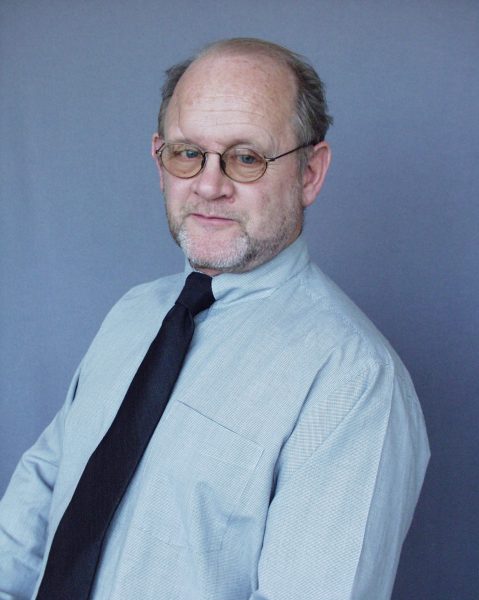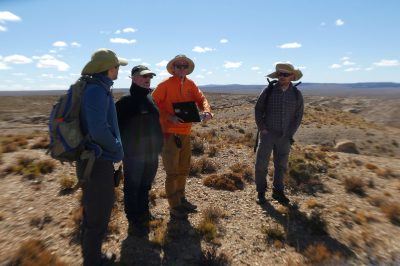Ronald Steel: Professor Emeritus
November 12, 2020

By Kristin Phillips
A former chair of the Department of Geological Sciences, Ronald Steel has built a career studying sedimentology and stratigraphy at field sites around the world. Now retired and with professor emeritus status, he has no plans of stopping anytime soon.
In 2013, after spending 41 years researching sedimentology and stratigraphy around the globe, Jackson School of Geosciences Professor Ronald Steel found the perfect field site: a spot five hours’ west of Neuquén, Argentina, on the eastern flank of the Andes. There, he and his students have traced the Jurassic rivers that flowed out onto an ancient continental margin and moved sediment into a marine delta system that was part of the evolving South American Pacific.
“This is one of about three places in the world where you can really ‘walk out’ across the ancient continental margin — the shelf, the continental slope and the deep-water submarine fans — because it is now uplifted well above the water,” said Steel.
Steel joined the Jackson School in 2003, holding the Davis Centennial Chair in Petroleum Geology, and was the chair of the Department of Geological Sciences from 2011 to 2015. In June 2020, he retired and now has emeritus status.
But that does not mean that his work will stop. Far from it.
“One of the things that happens when you begin to write papers, you discover that you are missing information,” said Steel. “So, we are returning soon to this really beautiful area.”
Steel grew up in Glasgow, Scotland, but spent his summers in his family’s old stone cottage on the Isle of Raasay; his grandfather belonged to the McLeod clan of that island. There, Steel would wander around, meeting students and professors and wonder what each of them was doing with a hammer and a notebook and a map.
By the time he started graduate school at the University of Glasgow in 1972, he was sewing together all of the bits and pieces of nonmarine Triassic rifted basins of northwest Britain into a more coherent paleo-geographic map by mapping the red-colored rocks on the Hebridean islands of western Scotland.
Steel’s early academic career was spent in Norway. Soon after finishing his doctorate — when oil exploration was just beginning in the North Sea — he got a position at the University of Bergen to train students in sedimentary geology. He also spent nine years working for the oil company Norsk Hydro.
“It was like heaven. It was the only way for me to get my hands on the new exciting marine geology of offshore Norway: the well, core and seismic data,” said Steel.
He returned to academia in 1990, first returning to the University of Bergen and then the University of Wyoming.
Steel’s research focused on how continental shelves arise globally and in the sequence stratigraphy made by sea level change, tectonics and climate over time. His expertise helped discover pockets where sand accumulated at the bottom of continental slopes, areas where ancient rivers dropped sediments that became the biggest reservoirs of oil and gas in the world. He also has mapped the tidal activity etched onto the marine rocks from the Western Interior Seaway, the shallow sea that stretched from Texas to Canada during the Cretaceous. During the past 10 years, he worked on larger-scale continental margins in the Jurassic Pacific margin of western Argentina, the South China Sea Neogene margin, and the Caribbean Orinoco margin of eastern Venezuela and the island of Trinidad.

Throughout his career, Steel’s research output has been exceptionally high — 260 papers and 11 books — and impactful, with nearly 18,000 citations and eight best paper or poster awards from various societies. In 2016, he received the Twenhofel Medal for outstanding contributions to sedimentary geology from the Society for Sedimentary Geology.
“Ron’s research covers the entire spectrum of siliciclastic sedimentology,” said Jackson School inaugural dean William Fisher, a fellow Twenhofel Medal winner and former department chair. “In recent years, Steel and his associates have significantly advanced our understanding of shelf-edge systems and their role in delivery of sediments to the deep basin. The Jackson School was most fortunate in recruiting this affable North Atlantic Scot by way of Wyoming and having him as a friend, colleague and associate.”
Steel is quick to point out that his many graduate students helped create this legacy. In total, he has supervised over 200 geologists at the University of Bergen, the University of Wyoming and The University of Texas at Austin. He plans to return to the beautiful field site in Argentina with some of his current students to finalize his mapping of that continental margin.
Back to the Newsletter